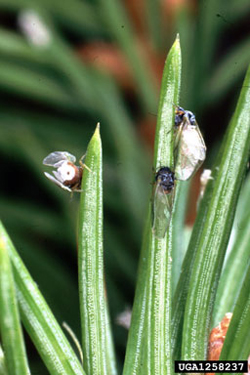DACF Home → Bureaus & Programs → Maine Forest Service → Forest Health & Monitoring → Forest Pest Index → Eastern Spruce Gall Adelgid
EASTERN SPRUCE GALL ADELGID
Adelges abietis (L.)

Photo: E. Bradford Walker, Vermont Department of Forests, Parks and Recreation, Bugwood.org
Symptoms and Damage
Green cone-like swelling at the bases of small twigs on Norway and white spruce usually indicate the presence of the eastern spruce gall adelgid. These galls are caused by the feeding of young nymphs (immature adelgids) that causes new needles to grow abnormally and fuse together in a light green swelling containing many insects. The galls, which are difficult to detect at first, later turn brown and become quite noticeable. Twigs so infested usually die. Individual trees vary greatly in their susceptibility to attack. Some trees will be heavily attacked while others nearby will have no galls at all. Old galls may remain on the trees for many years.
The galls reduce the attractiveness of Christmas trees and ornamentals and in severe cases may cause some tree disfigurement and stunting. Normally damage is considered aesthetic.
Hosts
Usually on Norway and white spruce although occasionally on red and Colorado blue spruce.

Photo: Stanislaw Kinelski, Bugwood.org
Life Cycle
This insect overwinters as small nymphs at the bases of buds. In the spring the nymphs molt to become stem mothers that lay eggs on the needles at about the time new buds are ready to break. The eggs hatch in about 10 days and the young nymphs begin feeding on needles. Feeding of the nymphs causes abnormal needle and twig growth resulting in the formation of pineapple-shaped galls. Gall tissue grows and encases the immature insects, protecting them from predators and other unfavorable conditions. The galls split open in late summer allowing mature nymphs to crawl out and molt to become winged, egg laying females. These females may stay on the host tree or fly to another, feed briefly, lay eggs on the bark and die. Eggs hatch in about two weeks and the overwintering nymphs attach themselves to twigs at the bases of buds.
Control
Non-chemical: Normally, fast growing trees will suffer less from aphid attacks. Slower growing badly infested trees should be cut and removed from a planting. For ornamental trees the individual galls can be clipped off and burned as soon as noticed in late May or early June.
Chemical*: The damage may be prevented by spraying infested trees in the spring before the buds open with dormant oil, carbaryl, or chlorpyrifos. Accurate timing of insecticide application just prior to budbreak is required for best protection of the tender elongating shoots. Refer to the insecticide label for specific use instructions, dosages, and precautions.
Pesticidal soaps (such as Safer's Insecticidal Soap), an alternative to petrochemical pesticides, are also registered for control of spruce gall aphids.
*NOTE: These recommendations are not a substitute for pesticide labeling. Read the label before applying any pesticide. Pesticide recommendations are contingent on continued EPA and Maine Board of Pesticides Control registration and are subject to change.
Caution : For your own protection and that of the environment, apply the pesticide only in strict accordance with label directions and precautions.
MAINE DEPARTMENT OF AGRICULTURE, CONSERVATION AND FORESTRY
Maine Forest Service - Forest Health and Monitoring Division
April 2000